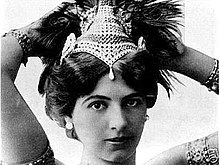
Back ماتا هاري Arabic ماتا هارى ARZ Mata Hari Azerbaijani Mata Hari BCL Мата Хари Bulgarian মাতা হারি Bengali/Bangla Mata Hari Breton Mata Hari Catalan Mata Hari Czech Mata Hari Welsh
Mata Hari | |
|---|---|
 Mata Hari, c. 1910 | |
| Born | Margaretha Geertruida Zelle 7 August 1876 Leeuwarden, Netherlands |
| Died | 15 October 1917 (aged 41) Vincennes, France |
| Cause of death | Execution by firing squad |
| Occupations |
|
| Spouse |
Rudolf John MacLeod
(m. 1895; div. 1906) |
| Children | 2 |
| Espionage activity | |
| Allegiance |
|
| Service branch | Deuxième Bureau |
| Service years | 1916–1917 |
| Signature | |
Margaretha Geertruida MacLeod (née Zelle, Dutch: [mɑrɣaːˈreːtaː ɣeːrˈtrœydaː ˈzɛlə]; 7 August 1876 – 15 October 1917), better known by the stage name Mata Hari (/ˈmɑːtə ˈhɑːri/ MAH-tə HAR-ee, Dutch: [ˈmaːtaː ˈhaːri]; Indonesian for 'sun', lit. 'eye of the day'), was a Dutch exotic dancer and courtesan who was convicted of being a spy for Germany during World War I. She was executed by firing squad in France.[1] The idea of a beautiful exotic dancer using her powers of seduction as a spy made her name synonymous with the femme fatale. Her story has served as an inspiration for books, films, and other works.
It has been said that she was convicted and condemned because the French Army needed a scapegoat,[2][3] and that the files used to secure her conviction contained falsifications.[4] Some have even stated that Mata Hari could not have been a spy and was innocent.[5]
- ^ "Mata Hari". Encyclopædia Britannica. Retrieved 21 August 2007.
The daughter of a prosperous hatter, she attended a teachers' college in Leiden. In 1895 she married an officer whose family was of Scottish origin, Captain Rudolph MacLeod, in the Dutch colonial army, and from 1897 to 1902, they lived in Java and Sumatra. The couple returned to Europe but later separated, and she began to dance professionally in Paris in 1905 under the name of Lady MacLeod. She soon called herself Mata Hari, said to be a Malay expression for the sun (literally, "eye of the day"). Tall, extremely attractive, superficially acquainted with East Indian dances, and willing to appear virtually nude in public, she was an instant success in Paris and other large cities.
- ^ "Why Mata Hari Wasn't a Cunning Spy After All". National Geographic. 12 November 2017. Archived from the original on 9 November 2019.
In 1916 the war was going badly for the French. Two of the longest and bloodiest battles of the war—Verdun and the Somme—pitted the French against the Germans for months at a time. The mud, bad sanitation, disease, and the newly introduced horror of phosgene gas led to the death or maiming of hundreds of thousands of soldiers. Eventually, French troops became so demoralized that some refused to fight. Ladoux felt the arrest of a prominent spy could raise French spirits and recharge the war effort.
- ^ Howe, Russel Warren (1986). Mata Hari: The True Story. New York: Dodd, Mead and Company. pp. x–xi, 285.
- ^ Jeffries, Stuart (16 October 2001). "Did they get Mata Hari wrong?". The Guardian. Retrieved 28 November 2022.
- ^ Goldsmith, Belinda (7 August 2007). "Mata Hari was a scapegoat, not a spy – biographer". Reuters.
'But the evidence is quite strong that she was completely innocent of espionage,' Shipman, a professor of anthropology at Pennsylvania State University, told Reuters. 'When she was arrested the war was going very badly for the French and she was a foreigner, very sexy, having affairs with everyone, and living lavishly while people in Paris had no bread. There was a lot of resentment against her.' Shipman said Mata Hari's standing in 1917 was similar to that of Marilyn Monroe in the 1960s—she was recognizable everywhere and considered the sexiest, most desirable woman in Europe. 'This is part of why it is so ludicrous to think she was a spy. She couldn't be clandestine and sneak around. She couldn't help but attract attention,' said Shipman, whose book Femme Fatale: Love, Lies and the Unknown Life of Mata Hari (ISBN 978-0297856276) has just been released.
© MMXXIII Rich X Search. We shall prevail. All rights reserved. Rich X Search